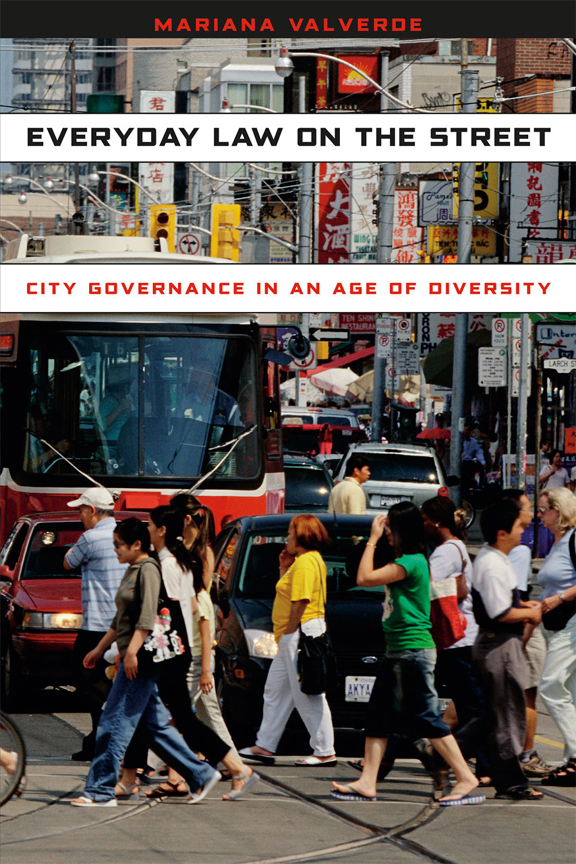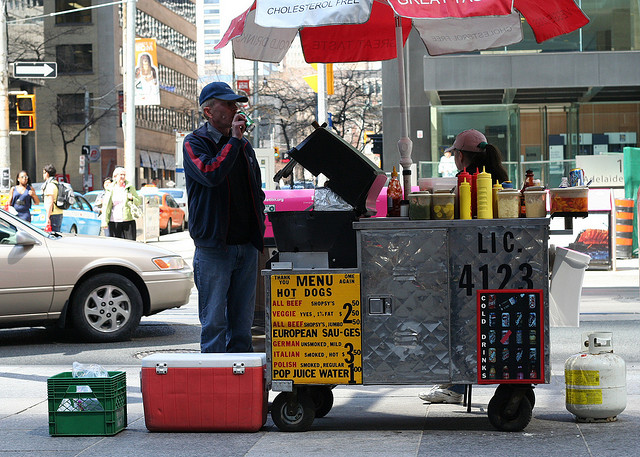
Toronto prides itself on being “the world’s most diverse city,” and its officials seek to support this diversity through programs and policies designed to promote social inclusion. Yet this progressive vision of law often falls short in practice, limited by problems inherent in the political culture itself. In Everyday Law on the Street, Mariana Valverde brings to light the often unexpected ways that the development and implementation of policies shape everyday urban life. Melina Cordero finds a well-researched and carefully crafted study.

Everyday Law on the Street: City Governance in an Age of Diversity. Mariana Valverde. University of Chicago Press.
In an era when cities across the globe are championing diversity, why are we witnessing an increase in inequality and social exclusion? Inspired by this ill-understood paradox, legal sociologist Mariana Valverde sets out to find the roots of this contradiction in her hometown of Toronto – an oft-touted icon of urban multiculturalism. What she finds is a set of structures and practices of municipal governance that, by promoting a culturally specific definition of diversity, is actually perpetuating long-held inequalities.
Everyday Law on the Street: City Governance in an Age of Diversity is a study of how deeply embedded biases continue to structure local governance in even the most outwardly ‘progressive’ of cities. Based on four years of on-the-ground research shadowing local officials and attending civic meetings, Valverde creatively combines anecdotes, case studies, and academic research to expose the ways in which local governance structures sew social exclusion into the fabric of ‘urban experience’. Controversially, she argues that many of the ideals dominating urban studies and shaping today’s urban governance structures – most notably, Jane Jacobs’s ‘village ideals’ and Richard Florida’s ‘creativity’ campaigns – are, in practice, outdated and ill-suited to the challenges of contemporary urban contexts.

In addition to her departure from popular and often blindly followed urbanist visions, Valverde makes two key contributions to urban governance studies. First, her focus on the legal dimension of metropolitan governance provides a perspective largely lacking in urban studies. For Valverde, the denigration of law and legal frameworks as mere ‘superstructures’ (as in the Marxist and culturalist traditions) overlooks the powerful role they play in shaping the everyday urban experience. Valverde’s second contribution derives from her focus on ‘the everyday’ – an undersubscribed but invaluable approach to advancing studies of contemporary urban governance. In the sociological traditions of Michel de Certeau (The Practice of Everyday Life) and Bourdieu (Distinction), Valverde’s study demonstrates how close study of the seemingly mundane aspects of urban experience can reveal key insights into the functioning – and failures – of urban governance.
In “The Legal Regulation of Taste: Annoying Noises, Unkempt Yards, and the ‘Quality and Tranquility of Life’” (Chapter 3), Valverde uses the example of Toronto’s ‘nuisance laws’ to demonstrate how local bylaws impose a set of culturally biased ideals. The very legal standards defining ‘cleanliness’ and ‘tranquility’, Valverde argues, are built upon the aesthetic and moral ideals of mostly white, middle-aged, middle-class property owners. Shadowing local inspectors on countless investigations, she also finds ‘systemic cultural prejudice’ in the highly unequal enforcement of nuisance complaints. The resulting system is one that affords different ethnic and socio-economic groups varying degrees of legal protection and further entrenches established inequalities.
These inequalities, Valverde continues, are reinforced by a local leadership structure driven by a highly disjointed, micro-local planning agenda – the subject of “City Bureaucrats and Village Elders: The Dysfunctional Dance of Local Government” (Chapter 4). For Valverde, everyday conflicts such as nuisance complaints are governed by a dysfunctional relationship between city bureaucrats, who enforce inherently biased rules, and local elected officials, who cherry pick issues to champion based on interest group politics. The resulting system, which Valverde terms ‘village elder politics’, establishes a planning regime that is both short-sighted and dangerously derivative of the American ‘Tammany Hall’ tradition.
If earlier chapters demonstrate how the city’s fundamental legal structures contribute to social exclusion, in Chapter 6 (‘Putting Diversity on the Menu: The Municipal Corporation and the Micromanagement of Street Life’) the empty nature of what Valverde calls ‘diversity talk’ is most flagrant. Here, she uses the example of Toronto’s highly regulated street vendors to demonstrate how local laws can and often do serve as mechanisms to limit diversity. Wading through the laws regulating vendors, Valverde finds overly tedious licensing procedures, exorbitant costs, and outdated restrictions such as the ‘compulsory hot dog law’ – a rule limiting vendors to the sale of ‘pre-cooked meat product in the form of wieners….served on a bun.’ For Valverde, these ‘Kafkaesque’ restrictions are driven by culturally specific and outdated associations of street vending with the ‘third world’. The ‘irrational fear of street vending’, often disguised as concerns for ‘public health’, led to the failure of a recent campaign to increase the cultural diversity of the city’s street vendors. Despite strong civic engagement and officials’ outward support of diversity initiatives, the push to ‘put diversity on the menu’ ultimately failed; governance structures, Valverde argues, were unable to overcome aesthetic and moral biases.

Across the book’s nine chapters, the advantages of Valverde’s methodology is clear; her on-the-ground study of local law and enforcement procedures allow for a myriad of anecdotes that offer not only colourful, but compelling evidence of the potentially exclusionary force of legal frameworks. As such, the study raises awareness of ‘silent’ but powerful legal forces and calls for further research into the impact of tacitly biased municipal law.
Given the power of this plea, the argument could have benefitted from a more pronounced discussion of its international relevance. While Valverde makes efforts throughout the book to draw links between her observations in Toronto and similar systems in American cities, closely related scholarship in other continents is curiously ignored. Studies of highly biased ‘rule by aesthetic’ and street vendor politics are recurring themes in urban governance literature of the ‘global south’. However, this point is less a critique of Valverde’s work than it is an appreciation for the global scope and relevance of her findings.
Ultimately, Valverde’s well-researched and carefully crafted study of how local legal frameworks can limit social inclusiveness reveals the potentially dangerous effects of decentralization and devolution. As state-wide and regional legal and planning frameworks are abolished in favour of micro-local governance structures across the globe (including the very contemporary case of England’s regional planning bodies), Valverde shows how such direction may not be the best approach for promoting diversity and limiting the inequality found in today’s cities. As such, Everyday Law on the Street is a book not only for legal and urban scholars, but for planners, civic leaders, and politicians – an audience as diverse as the cities we celebrate.
—————————————————————————————–
Melina Cordero completed an MSc in Urbanisation and Development at LSE in 2011, part of the Double Degree Programme in Urban Policy administered jointly with Sciences-Po Paris. Her programme combined study in both international development and geography with an emphasis on cities in the ‘Global South’ and, in particular, Latin America. Since graduating from LSE, Melina has submitted her dissertation for publication in several urban studies journals and she is hoping to undertake PhD study in Geography and Urban Planning later this year. Read more reviews by Melina.





